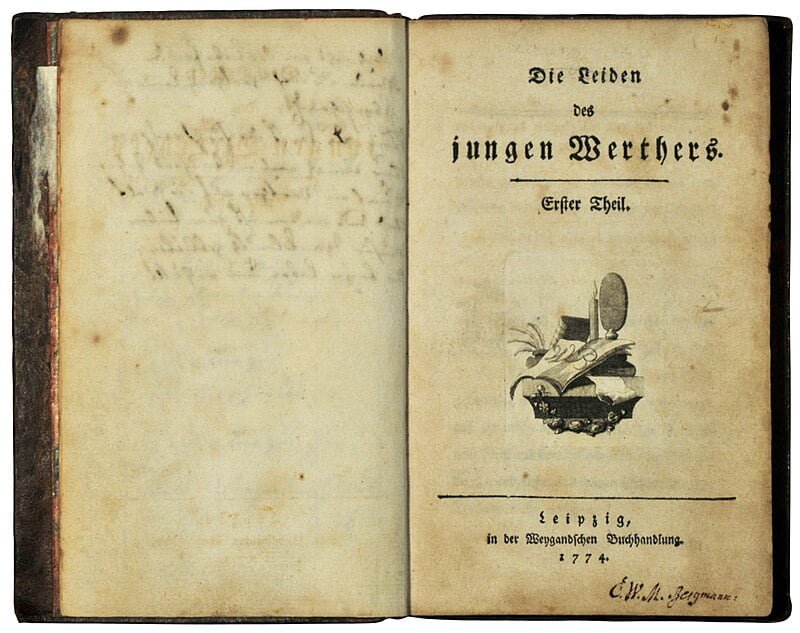Johann Wolfgang von Goethe’s “The Sorrows of Young Werther” was penned during a tumultuous yet intellectually invigorating era in Germany. The second half of the 18th century marked the Enlightenment, a period characterized by an emphasis on reason, individualism, and a questioning of traditional authority. Within this climate of intellectual ferment arose the “Sturm und Drang” movement, a counter-Enlightenment literary surge that celebrated emotional intensity, natural genius, and the depths of human passion. “Sturm und Drang,” translated as “Storm and Stress,” prioritized creative originality and the uninhibited expression of emotions, aspects that are palpably reflected in Goethe’s novel.
Goethe composed “The Sorrows of Young Werther” when he was in his mid-twenties, drawing upon his personal experiences and emotional turmoil. Born in 1749 in Frankfurt, Goethe demonstrated prodigious talent from a young age, excelling in both literature and law. His early career was shaped by a blend of legal training and literary pursuits, transitioning passionately into the arts. Living during a period of significant literary and cultural dynamism, Goethe encountered contemporary figures such as Friedrich Schiller, who considerably influenced his work. The literary environment was ripe with explorations into human subjectivity and the natural world, themes Goethe deeply integrated into his novel.
Published in 1774, “The Sorrows of Young Werther” emerged as a defining piece of the “Sturm und Drang” movement. Its portrayal of the protagonist’s intense and ultimately tragic love affair resonated profoundly with readers, catapulting the young Goethe to international fame. The novel’s initial reception was nothing short of sensational, eliciting a wave of emotional responses and even sparking a fashion trend that imitated Werther’s distinctive style. In 1787, Goethe reprinted the work, which continued to enjoy widespread acclaim, cementing its status as a classic. Critics and readers were captivated by its raw expression of unrequited love and existential despair, themes that were both novel and confronting at the time.

Plot Summary and Major Themes
“The Sorrows of Young Werther,” penned by Johann Wolfgang von Goethe, revolves around the intense emotional journey of its protagonist, Werther. The narrative chronicles Werther’s passionate and deeply melancholic love affair with Lotte (Lohtéa), an enchanting young woman who is betrothed to another man, Albert. Despite Lotte’s engagement, Werther’s infatuation with her becomes all-consuming, leading him down a path of escalating despair.
The novel delves into Werther’s inner world, capturing the poignant dialogues and letters he pens to his friend, Wilhelm. These communications offer profound insights into his emotional turmoil and the unrequited nature of his love. As Werther’s affection for Lotte grows, so does his disillusionment, ultimately culminating in a tragic conclusion that underscores the novel’s exploration of human passion and frailty.

A central theme in the novel is unrequited love, exemplified by Werther’s relentless and unrewarded devotion to Lotte. This theme is intricately tied to the concept of longing and the inevitable suffering that accompanies it. Furthermore, the story emphasizes individualism, portraying Werther as an archetype of the Romantic hero – deeply emotional, introspective, and somewhat isolated from the societal norms.
Another significant theme is the clash between emotion and reason. Werther embodies the Sturm und Drang movement’s ethos, favoring heartfelt emotion and instinct over rational thought and societal expectations. His preference for visceral experiences often places him at odds with the more pragmatic and rational characters, such as Albert.
The influence of nature on human sentiments is also vividly portrayed in the narrative. Goethe’s use of pastoral settings and natural imagery reinforces Werther’s emotional states, illustrating how the protagonist draws solace and reflection from the natural world around him. The ebb and flow of nature parallel Werther’s tumultuous inner life, accentuating the novel’s Romantic ideals.
Through the exploration of these themes, “The Sorrows of Young Werther” offers a poignant and enduring commentary on the complexities of the human condition, striking a chord with readers by capturing the essence of raw, unfiltered emotion and its profound impact on the individual’s psyche.
Impact and Influence on Literature
“The Sorrows of Young Werther,” penned by Johann Wolfgang von Goethe, holds a distinguished place in the annals of literary history for its profound impact on both contemporary and subsequent literary landscapes. As a cornerstone of the Sturm und Drang movement, the novel catalyzed a significant shift towards Romanticism, marked by an emphasis on emotional depth and individual experience. Its influence quickly spread beyond Germany, resonating deeply in France, Italy, and England, where it helped fuel the burgeoning Romantic movement.
In France, the novel’s exploration of intense emotional states and individual consciousness found a kindred spirit in writers like François-René de Chateaubriand and Alphonse de Lamartine, who embraced the melancholic and introspective facets of Romanticism. Similarly, in Italy, authors such as Ugo Foscolo echoed Werther’s themes of unrequited love and existential despair, embedding them into the fabric of Italian Romantic literature. England, too, witnessed an infusion of Wertherian influence, with poets like Lord Byron and William Wordsworth drawing inspiration from Goethe’s portrayal of nature as a reflection of human emotion.
“The Sorrows of Young Werther” did more than shape literary themes; it sparked what can only be described as Werther-mania across Europe. This cultural phenomenon saw readers, particularly young men, imitating Werther’s style of dress and melancholic demeanor, epitomizing the novel’s widespread appeal. The blue frock coat and yellow trousers worn by Werther became a fashion statement, symbolizing the yearning and turbulence of youthful passion.
Intellectuals and artists of the era were equally captivated. The book’s exploration of the human psyche and emotional turmoil resonated with painters and composers, inspiring works that captured similar themes of longing and despair. Beethoven’s music, for instance, can be seen as imbued with the same rich emotional undercurrents that characterize Goethe’s writing. Even beyond the arts, the novel stirred conversations among philosophers and thinkers, contributing to a broader intellectual movement that questioned the role of emotion and reason in human experience.
Legacy and Modern Relevance
‘The Sorrows of Young Werther’ remains one of the most influential works in world literature, retaining its profound impact long after its initial publication in 1774. Goethe’s novel, a quintessential piece of the Sturm und Drang movement, continues to be widely studied in educational syllabi around the globe. Its exploration of intense emotional experiences and the complexity of human suffering resonate significantly with both historical and contemporary audiences.
The story’s universal themes of unrequited love, existential despair, and the quest for personal authenticity have transcended time and cultural boundaries, ensuring its sustained popularity. Educational institutions often include ‘The Sorrows of Young Werther’ in literature curricula to illustrate the romantic idealism and emotional fervor characteristic of the late 18th century. The novel is not only a vehicle through which students can engage with the Sturm und Drang movement but also a gateway to understanding broader romantic literary traditions.
Adaptations of ‘The Sorrows of Young Werther’ into various media, such as film, theatre, and music, further attest to its enduring legacy. These adaptations offer fresh perspectives and new interpretations, making Goethe’s work accessible to diverse audiences. For instance, theatrical renditions have explored different cultural contexts and historical periods, showcasing the novel’s adaptability and timeless relevance.
Scholars and literary critics have continually reflected on the significance of Goethe’s masterpiece in modern contexts. According to literary critic Albert Wertheim, “Werther’s tragic fate and profound emotional depth continue to speak to our own human experiences, making it an ever-relevant piece of literary art.” Similarly, academic examinations by scholars such as Roland Laudenbach have highlighted the novel’s exploration of individual subjectivity and emotional intensity as reasons for its lasting appeal.
The lasting resonance of ‘The Sorrows of Young Werther’ can be attributed to its incisive portrayal of the human condition. In a world where the struggles of personal identity, emotional turmoil, and the quest for meaning remain prevalent, Goethe’s work offers poignant insights and reflections. The novel’s ability to stir empathy and introspection speaks to its enduring legacy and modern relevance in the canon of world literature.

